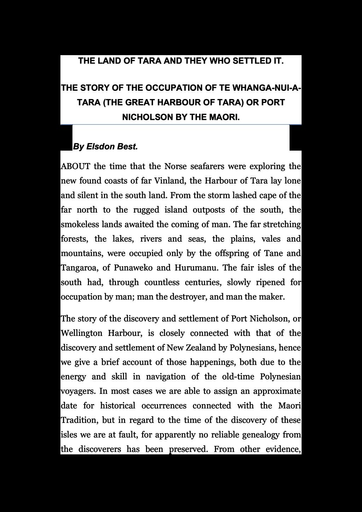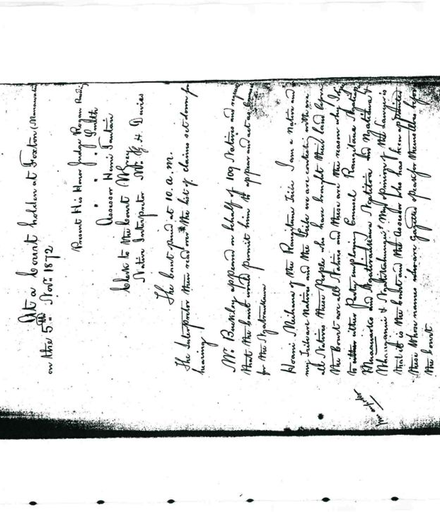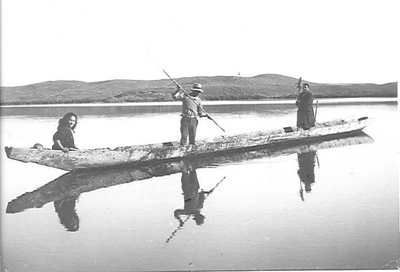Muaupoko tupuna kōrero
- Description
WHATONGA
|
TARAIKA
|
PEHUNGAITERANGI
|
TIWHANARANGI
|
HINEONE
|
KOTAHU
|
TE RANGITUPEWA
|
TUMARORO
|
TUKUPOU
|
TUPAHUNGAITERANGI
|
TE RANGITAPU
|
TURANGATAHI
|
HIKATOATOA
|
PARIRI
|
TUI
WHATONGA: Moves from Nukutaurua and lives at Ahuriri (Napier), builds the house Heretaunga.
TARAIKA: Born in Heretaunga at Te Rangiwhakaoma, has Pa at Waimarama (Te whanagnui-o-Tara), Napier Harbour (Marae-a-Tara), names an Island after his wife, Umuroimata (Park Island), he had lakes reserved for him, Te Roto-aTara, Poukawa, Te Roko-a-Kiwa and Te Wai-o-Tara. He moved to Wellington which his wife named Te Whanganui-a-Tara. Tara first settle on Matui (Sommes Island), they built two Pa, one was called Haowhenua (at the site of present quarantine station) and the other Te Moana-a-kura on the ridge at the Northern end of The Island. They built three houses on the Island Haere-moana (ocean traveling), Aotea-roa (His landfall) and Te Pu-o-te-tonga (the true south).
PEHUNGAITERANGI: Married Uiratea, a greatgrandaughter of Turi of the Aotea waka.
TE RANGITUPEWA Lived at Puhirangi Pa on Seatoun Ridge, with his wife Ihunui-o-Tonga.
TE RANGITAPU: Had a Pa called Te Ihutoto at the Maungaraki Trig, Wairarapa
A tukuwhenua of land was made by a group of Ngai Tara to Ngati Ira. These Ngai Tara then left for Te Waipounamu. Turangatahi who was married to Manukura, a sister of Te Huataki, Te Kuratapu and Pouwakataka remain on the land there. Turangatahi was attacked and captured at the fall of Okahu Pa. He was saved from death by Rakairangi, who threw his cloak over Turangatahi. Which made him safe from the Taua. Turangatahi was ransomed by Ngati Ira for grants of land. Hikaotaota was a daughter of Turangatahi, she was taken prisioner at Wainui. Te Uira, who was from Punahu hapu, took her to Te Uruhi and she married Ngataitoko, that was his land.
WHATONGA
|
TARAIKA
|
WAKANUI
|
TURIA
|
HINEITI
|
TE MONINUKU
|
TAPAPOHATU
|
TE AOHURUHURU
|
TE UMUTAHI
|
UENGARANGI
|
MANUKIHAU
|
HIKATOATOA
|
PARIRI
WHATONGA: Whatonga explored the coast and areas from Heretaunga to Wairarapa to Wellington. He went to Te Waipounamu and return via the west coast of the North Island. He meet Turi of the Aotea Waka on the manawatu Coast, before turning Inland and returning to Heretaunga.
TARAIKA: When Tara left Matiu, he and his Ngati Hotuwaipara hapu built the Pa Whetu-kairangi (stars twinkling in the sky), which was named by his wife Umuroimata. Te Puna-a-Tara was a spring at Worser Bay which serviced this pa. Kirikiri-tatangi was a Mahinga Kai at Seatoun Flat on the eastern side of Te Whetu-kairangi. Pae-kawakawa was a valley were Hinekiri (a daughter of Tara) had her kumara plantation
WAKANUI: He was drowned when his waka Nga Toto overturned near Nga Whatupaipono (the Brother Islands) in Raukawakawa (Cook Straight) when he was going to visit relations at Kapiti Island.
TURIA: Married Hinematua, a great granddaughter of Tangowhiti who lived near Waipukurau.
Kupe
|
Matangi-rupe
|
Karotaha
|
Taia-te-hokea
|
Horouta
|
Amarunui
|
Amarupuhake
|
Ihinga-ariki
|
Rotorua
|
Tupatunui
|
Amarumoari
Tupatunui first lived at Taikoria, north of Manawatu. He had a house there called Tauakira and a ngarara called Whangaimokopuna in a cave there. His hapu was Ngati Kauwae. Tupatunui fled south through fear of Ngati Apa, and took up abode at Paekakariki. Tupatunui was killed at Te Ana-o-Hau-Pukerua by Ngati Ira (Ngati Tuhakeke and Ngai Tara) and his head was cut off and put on a stone, do not know what was done with his body. His death was avenged by his relations of Ngati Apa and Muaupoko who defeated Ngai Tara, who then fled to the South Island.
Tupatunui sent his son Amarumaori to Moutere to live, the name of his house there was Nga Hihi-o-te-Ra.
Ngataitoko lived at Papaitonga after his relation Rangiheke left, he also had Pa at Waikanae and Pukerua. Hikaotaota was a Hamua, she was taken prisioner at Wainui, in Wairarapa. Te Uira took her to Te Uruhi and she married Ngataitoko there, that was his land. She lived at Waitawa and Papaitonga after the marriage.
Tupatunui
|
Amarumoari
|
Rereao
|
Tama-ki-te-hau
|
Taingaruru
|
Whakarongotai
|
Ngataitoko = Hikatoatoa
Te Uira was later killed at Otaewa by Ngataitoko and other people of Hamua. Ngataitoko returned to Papaitonga after this. Tupohonui took Te Mou, the son of Te Uira, to Ihurakau. He had been disguised as a girl child so that he would not be discovered and killed.
Ngataitoko and Hikaotaota had three daughters, Kawainga the oldest, Rongopatahi and then Pariri the youngest. Kawainga lived at Waikanae and eventually went to Wairarapa.
Te Rongopatahi lived at Paekakariki. Her boundary with Tukatoatoa descendants commenced at Raumatangi, to Te Reti, to Pakingahau, then turning westward to Taingaehe, then north passing west of Moutere to Pakauhokio, thence to Whangaingai, thence to Ngatokorua and northward. The Ngati Kokopu hapu lived to the seaward side of this boundary.
Pariri and Te Rongopatahi made a boundary between them. It commenced at Hokiopuni, thence to Tirotirowhetu, thence to Ohenga, thence to Patoitoi, thence to Te Koropu, thence to Tutohu, thence to Te Umutawa-a-pariri, thence to Te Urunga-o-huatau, thence to Te Arapaepae, thence to the summit of Tararua.
Pariri first lived at Waipata and Pukeiti. Then she lived at Matanginui and at Otaewa. Takapukaiparao was another kainga occupied by Pariri and her descendants. Pariri had Pa at Pukerua and Paekakariki she lived there because she married Te Hukui, a son of Te Koro-o-nga-whenua. Te Hukui married Pariri between Te Horo and Waikanae, they were his lands. Both Pariri and Hukui died at Horowhenua. Hukui was buried there, Pariri head was taken to the Hamua ana at Ruamahanga near Masterton.
Te Rangiheke lived at Papaitonga and Muhunoa. A party of Rangitane invaded the district under the chiefs Tawhakahiku and Mangare. They came to Wheteriki, near Papaitonga and saw Aitupaoa in a tree. His wife was at the foot of the tree and they killed her. Aitupaoa took refuge in the Pa at Papaitonga, and told his friends of the arrival of Tawhakahiku and Mangare. Te Rangiheke determined to attack them on the mainland. Tawhakahiku and Mangare were engaged and killed at Te Reporoa by Aitupaoa and Te Rangiheke and their people.
Tupatunui
|
Amarumoari
|
Aorere
|
Te Rangiheke
|
Te Koko-o-nga-whenua
|
Te Hukui
Wharekohu and her people, Ngai Tara and Rangitane, were to avenged Mangare and Tawhakahiku. Te Aitupaoa and his people (Ngati Mamoe and Ngai Tara) were killed at Horowhenua. Some of them fled and were driven away, and went to the South Island. The Ngati Mamoe and Ngati Houhia were some of the original occupants of the land.
Te Rangiheheke
|
Te Koro-o-nga-whenua
|
Te Hukui = Pariri
|
Hine-i-tohia
|
Te Rangihikaka = Waha
Te Rangiheke went south to Waitawa and Otaki and Te Horo. He took his son Te Koro-o-nga-whenua with him. Te Rangiheke occupied south of Ohau stream, adjoining his ancestor Tupatunui boundary. This land extended to the Waikanae River, south of the Waikanae lived the Ngai Tuura and Ngati Rongomai hapu. Te Koro-o-nga-whenua came from the south to marry.
Te Rangihikaka was a son of Te Angi-i-mua and Hine-i-tohua and he lived at Papaitonga. Te Rangihikaka built Waipata and Pukeiti fighting Pa. He had four children to his Ngati Rangi wife, Te Waha. They were, Kiore, a son, Whitirea, who married Kahoro and was an ancestor of Tanguru and Major Kemp, Matiti and NihoThe land seaward of Moutere belonged to Ngati Kura and Ngati Kokopu and Ngati Puiti, Ngati Pouwhenua and Ngati Maikuku. Their rangatira was Ngamahi of Ngati Kokopu. He lived at Upokopoito, near the mouth of the Manawatu River and had eel-lagoons at Paekakariki, north of Poroutawhao. Nga Mahi and his Hapu, Ngati Kokopu and others, had a settlement at Te Reti.
Their lived a man called Te Piro who lived at Kouturoa. Oneday when Te Piro went to take eels at Te Waha-a-te-ngarara Pa, at Manawatu. Ngamahi found him there, and destroyed his eel pot and basket. Te Piro, in revenge, stole and idol of Ngamahi and brought it to Te Rangihikaka. Te Piro complained to Te Rangihikaka, who said “Me te mea nei koe he tamariki, te patu ai koe i te ngarara o uta ka patu ai nga ika o te wai”. Te Rangihikaka drove Ngamahi and his Hapu of the land, some of the survivors fleeing to the Ngati Apa and Rangitane. Te Rangihikaka bewitched a woman called Hengahenga for stealing from his Kumara cultivation. Te Rangihikaka went to Wairarapa with his daughter (Te Niho) as she was to marry a relation of Makere. While there he was bewitched by Pohokura. He remained and died there at Ruamahanga
Te Rangihikaka = Waha
|
Kiore
|
Tangata-atua
|
Turikotuku
|
Pene Tiakara (Bene Stickle)
|
Heni Pene Tikara (Jane Stickle)
Kiore lived at Pewarangi .
Tangata-atua lived at Horowhenua, she married at Waitawa
Turikotuku lived at Waitawa. Wahine-kairakau was a cultivation the descendants of Turikotuku.
Ben Stickles born here, was whanagai by Hanita Kowhai, married his daughter, about 1863. He returned here after Christianity was introduced. He later married Riria Wirihana
PARIRI = Te Hukui
|
TUI = Hura-te-papa
|
TE AOWHAKAPUPU = Tara
|
HINEMATAHIRANGI = Te Hukui
|
HIMINGA = Haua
|
RITITIA RARORARO = Tarawahi
|
RAHIRA = Wirihana Tawero
|
RIRIA =PENE TIKARA
Some say Pariri and Te Hukui were burried at Waikoukou. Hura-te-papa, Tui and Hura-te-papa lived at Pewarangi (buried at Otaewa)
Te Aowhakapupu at Horowhenua, buried at Kouturoa
Hineimatahirangi lived at Horowhenua
Heminga lived here, died here
Raroraro lived and buried at the Pa. Rahira, Wirihana and Riria lived at Te Rae-o-te-karaka. Wirihana died at Waitotara on his return from Parihaka.
Ben was a farmer. He had been putting trig stations with Mitchells Survey in 1872 / 73 upon the ranges. A dispute arose at the Waiwiri stream between Te Puke and his Ngati Huia of Ngati Raukawa who had a small fishing village on the south side of the stream. The stream mouth changed and they became on the north side of the boundary. Ben had stock running at the Mahoenui clearing, which also came under despute with some Ngati Raukawa who stoped frequenting the place in 1873. In 1873 he attended the Maori Land Court sittings. He accompanied the Survey of the boundary between Ngati Raukawa and Muaupoko with Hoani Puhi and some others.
Te Tira-o-Kotuku
After Waiorua Kotuku decided to go to his relations at Arapaoa and he went to Taueki and said “you remain here we will return”. The descendants of Kopani are the section of Muaupoko known as Koura ma whitiwhiti. Parikautuku was the only descendant of Kopani who didn’t go. Te Tira-o-Kotuku was the Koura ma whitiwhiti. Tairatu was the father of Kotuku. Tairatu went to take possession of Waiarawa. Rangihiwininui killed his slaves. When Tairatu returned he found that his slaves had been killed and he then went to the South Island with Kotuku.
Kotuku was married to Maewa of Ngati Pariri at Horowhenua and Hiku of Ngati Kuia at Arapaoa. Hiku was a sister of Tamairangi. E.W.Pakauwera states that Kotuku was the leading Rangatira of Ngati Apa ki te Ra To at the time of Te Rauparaha raids.
Some of those who went were:
Hone Tupou , Te Meihana Tupou, Ema Te Whango, Rihari Tarakihi, Taiata, Mohi Te Whuimaiwaho, Pirihira Hautapu, Hana Kotae, Metapare, Amorangi Rihara , Noa Te Whata, Raneira Te Whata , Hopa te piki , Paki Te Hunga, Nati Amorangi, Tauhinu, Mahuika, Te Whakahinga and Hoani Puihi.
Kotuku was married to Taiata of Ngati Pariri at Horowhenua and Hiku of Ngati Kuia at Arapaoa. Hiku was a sister of Tamairangi. E.W.Pakauwera states that Kotuku was the leading Rangatira of Ngati Apa ki te Ra To at the time of Te Rauparaha raids.
Tupou was captured at Moutere. He did not want his children to be made slaves so gave a pounamu patu to Ngati Rarua so they would be killed by a rakau rangatira. Mere Nako stepped in and save the tamariki by claiming them. Kotuku and Paihora were the principle rangatira at Te Taitapu, on the coast. The taua went on to Te Awaruatohu (Big bay) where there they captured Kotuku and Patukekeno of Puketapu killed him. Tairatu and Komakorau were also killed. Mohi Te Whuimaiwaho, his wife Pounamu and his daughter Pirihira Hautapu escaped as did Tauhinu and his son Mahuika. Paihora was killed by the Taua at Tawangahou.
Mohi returned and died in Horowhenua. Herewini Rakautihia lived with Pukekohatu of Ngati Rarua and Metapere married a Ngati Rarua. Ema Te Whango, Hopa Te Piki, Hone Tupou, Hera Tupou, Meihana Tupou, Raniera Te Whata lived at Arapaoa. Rihari Tarakihi lived at Te Parapara. They were brought back by Taueki, Hoani Puhi and others in canoes procured from Nepia Taratoa and Te Rangiwetea.
Whakapapa: 1
RAIKIHERE
|_________________________________________
| |
WHAREWAHINE = HINERA NGATAKITAHI
|________________________________________________
| | |
KAPA = MANATU POUNAMU = MOHI (TAUTINI) TUPOU
(2) (3) (4)
Whakapapa: 2
KAPA = MANATU
|
RURU = TEUREI
|
REE = WHAKAKA
|___________________________
| | | |
TUIPA HUTANA IHAKA HEHE
|
RANIERA
Whakapapa: 3
POUNAMU = MOHI (TAUTINI)
|_____________________
| |
KEREOPA PURUA PIRIHIRA HAUTAPU
| |
KERE = PIPI NGAURU
|
NOTI
Whakapapa: 4
TUPOU = PETI KOHU
|________________________________
| | | |
HONE RAHERA WAATA MEIHANA
|______________________________________________________
| | | | | | |
TUHI MI TE HORO PAHAU PUTIPUTI HARIATA RORE
Whakapapa: 5
Kopani = Te Kapo
|______________________________________
| | |
Marewa = Tairatu Taniwha Wairaka Wera
| |
Kotuku = Taiata
| ____|____________
| | |
Komakorau = Hopa te Piki Peti Kohu = Tupou
| | |
Iritana Rihara Tarakihi Hone Tupou = Mihi Te Rina
Whanau History.
Hone Tupou and his children along with his sister Rahera and his brother Waata where recorded in the Ngai Tahu list for South Island Native Settlements (JHR 1892 G1) as follows;
Name: Living at:
Tuhi Hone Tupou Horowhenua
Mi Hone Tupou Horowhenua
Te Horo Hone Tupou Horowhenua
Pahau Hone Tupou Horowhenua
Putiputi Hone Tupou Horowhenua
Hariata Hone Tupou Horowhenua
Te Rore Hone Tupou Wairau
They were given SILNA lands at Roallen. Te Horo was given SILNA land at Port Gore. Their uncle, Meihana Tupou, was given land at the Wairau. They were recorded as claimants to lands in Horowhenua through their Muaupoko whakapapa (AJHR 1898 G2).
Te Rore was living in the Wairau learning how to be a jockey and lived with the Pukekohatu whanau, but returned to Horowhenua. He married Heni Pene Tikara (Jane Stickle) and their children took the name Rore.
Heremaia Mohi = Heni Pene Tikara = Te Rore Hone Tupou
| |
Kapuarangi Mohi Puna Rore
| |
John Moses Jane Elizabeth Rore (Hotereni)
| |
Mark Moses Tai Karena
Hoani Puhi: Pg 108 / PP G2:1898
Hoani Puhi pg 110,Rawinia Ihaia Pg 116, Raneira Te Whata 138: PP G2: 1898
Hoani Puhi pg99
Raraku Hunia pg 38
Hoani Puhi pg 100
Rawinia Ihaia pg 98
Makere Te Rou pg 129
Raraku Hunia pg 37
Raneira Te Whata (Mokinokino) pg 111
Kerehi Mitiwaha
Raraku Hunia pg 38
Te Rangihiwininui keepa pg 150
Hoani Puhi pg 98
Identification
Taxonomy
- Community Tags










